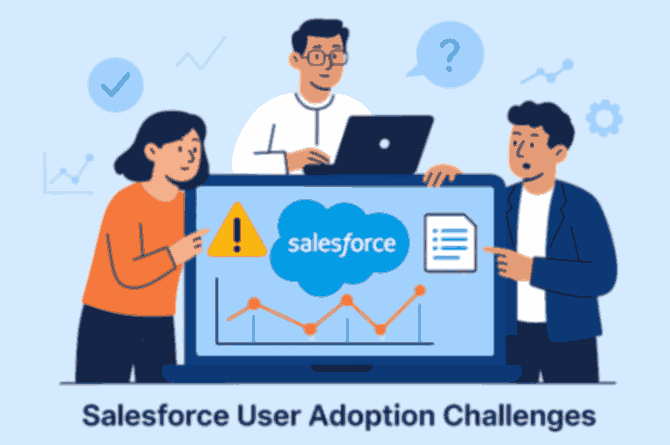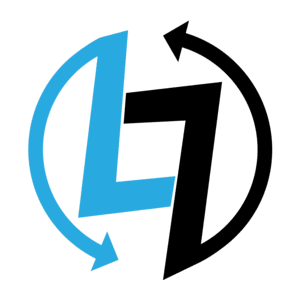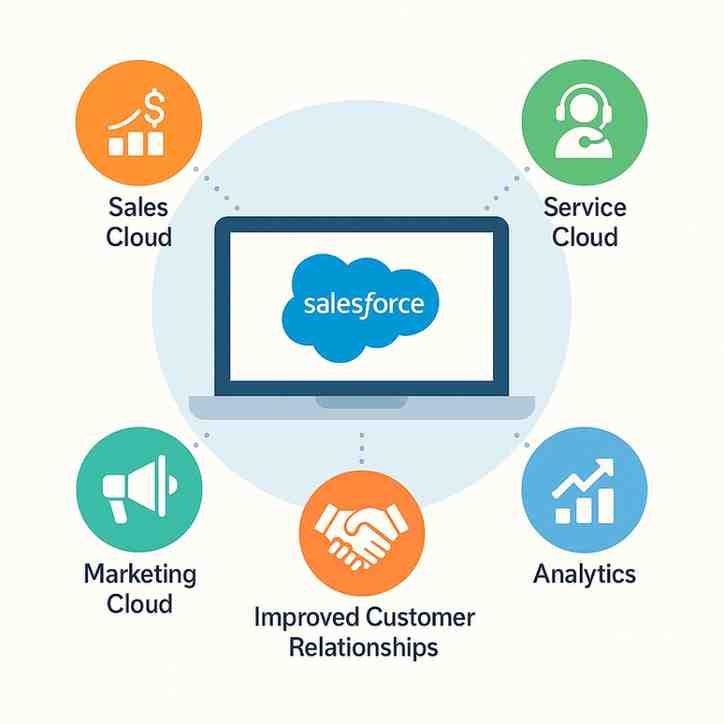Salesforce is widely regarded as one of the most powerful and customizable Customer Relationship Management (CRM) platforms available today.
With capabilities spanning sales, service, marketing, analytics, and automation, it’s no surprise that businesses across the globe invest in Salesforce to improve productivity and drive growth. But here’s the truth: the success of Salesforce doesn’t come from features alone – it comes from Salesforce user adoption.
A CRM system, no matter how robust, becomes ineffective if employees don’t fully embrace it. Unfortunately, Salesforce user adoption is one of the most persistent challenges organizations face during and after Salesforce implementation.
In this article, we’ll explore the most common Salesforce user adoption challenges and offer proven strategies to overcome them – ensuring your Salesforce investment delivers lasting results.
Why Salesforce User Adoption Matters
CRM tools like Salesforce are designed to centralize customer data, streamline operations, and provide critical business insights. But without consistent and enthusiastic user engagement, the platform becomes a digital filing cabinet with poor data, low visibility, and missed opportunities.
Improving Salesforce user adoption leads to –
-
Higher data quality and accuracy
-
Better forecasting and reporting
-
Increased sales productivity
-
Enhanced collaboration between teams
-
Greater return on CRM investment
Top Salesforce User Adoption Challenges and How to Solve Them

Lack of Visibility into Sales Performance
The Challenge –
When sales teams don’t have a clear view of their performance metrics – like conversion rates, deal stages, or sales cycle lengths – frustration builds quickly. This lack of visibility often leads to incomplete data entry or complete abandonment of the platform.
The Solution –
-
Create intuitive dashboards and real-time reports that showcase key KPIs.
-
Customize reports for different roles (e.g., sales reps, managers). Create intuitive dashboards for roles like sales reps, managers, and marketing.
-
Set up automated alerts and email reports to keep the right people informed.
-
Ensure reports align with users’ daily workflows to keep them engaged.
Pro Tip: Use visual tools like charts, graphs, and gauges to make insights easily digestible and actionable.
Difficulty in Conducting Pipeline Reviews
The Challenge –
Managers often struggle to transition from manual or spreadsheet-based pipeline reviews to Salesforce’s data-driven system. Without clear guidance, this shift can feel overwhelming. Many users don’t take full advantage of Salesforce’s powerful reporting features, leading to missed insights and poor visibility.
The Solution –
-
Provide hands-on training focused on Salesforce tools like Opportunity Management, Sales Path, and Forecasting.
-
Encourage managers to lead by example and conduct reviews directly within Salesforce.
-
Use reports to guide meetings and performance reviews.
-
Implement easy-to-use templates for pipeline reviews to help teams adapt.
- Train users on how to build and customize reports.
Bonus Tip: Run mock pipeline reviews during training to build confidence before going live.
Insufficient Dashboard and Report Usage
The Challenge –
Salesforce can be overwhelming without proper dashboards and visualizations. Users often find it difficult to extract meaningful insights, leading to disengagement. If Salesforce isn’t customized to the users’ needs, it may feel cluttered or difficult to navigate, discouraging regular use.
The Solution –
-
Begin with basic dashboards aligned to core business goals.
- Simplify page layouts and remove unnecessary fields.
- Customize dashboards to show relevant KPIs.
-
Expand functionality gradually – start with lead and opportunity tracking, then move into automation and analytics.
-
Provide continuous training and role-specific onboarding.
- Gather feedback and iterate on design regularly.
Advanced Tip: Leverage third-party dashboard apps or native Salesforce tools like Lightning Experience to enhance user engagement.
Poor Leadership Adoption and Engagement
The Challenge –
If sales managers don’t actively use Salesforce or demonstrate its value, their teams are unlikely to follow suit. Leadership disengagement is one of the top reasons for failed CRM adoption. When executives and managers fail to actively use or promote Salesforce, employees follow suit.
Leadership apathy sends the message that Salesforce isn’t essential.
The Solution –
-
Involve sales leaders early in the implementation process.
-
Empower them to tailor dashboards and reports that support their decision-making.
-
Encourage them to regularly reference Salesforce data during team meetings, 1:1s, and performance reviews.
-
Celebrate data-driven wins to reinforce the platform’s value and to build trust in the system.
Leadership Hack: Assign executive sponsors to champion the platform and drive cultural adoption across departments.
Underestimating the Learning Curve
The Challenge –
Salesforce is not a plug-and-play solution. Its vast features, customization options, and integrations can overwhelm new users – especially those unfamiliar with CRM systems. Salesforce has a steep learning curve. Without proper training, users feel overwhelmed and revert to legacy systems like spreadsheets or email.
The Solution –
-
Break training into bite-sized, role-based learning paths tailored to each department.
-
Offer a mix of live training and workshops, recorded tutorials, Q&A sessions, and hands-on sandbox sessions.
-
Establish a Salesforce support group or internal champions who can offer peer assistance.
-
Gradually roll out new features to prevent overload.
- Offer refresher courses and update training when features change.
Tip for Long-Term Success: Use interactive tools like Salesforce Trailhead modules to provide continuous, self-paced, gamified learning.
Additional Salesforce User Adoption Challenges and How to Solve Them
Poor Data Quality and Duplicate Records
The Challenge –
Users lose trust in the system if it’s filled with duplicate, outdated, or inaccurate data.
The Solution –
- Establish clear data entry standards and best practices.
- Enable validation rules and duplicate detection.
- Clean up existing data using Salesforce tools or third-party apps.
- Assign data stewards to monitor quality.
Lack of Clear Benefits for Users
The Challenge –
If users don’t understand how Salesforce makes their work easier or more rewarding, they won’t be motivated to adopt it.
The Solution –
- Communicate the value of Salesforce clearly and consistently.
- Align Salesforce usage with individual and team goals.
- Gamify adoption with leaderboards, contests, and rewards.
- Highlight time-saving features like automation and templates.
Resistance to Change
The Challenge –
Change is hard – especially for employees used to older systems or manual processes.
The Solution –
- Address concerns early and involve users in the implementation process.
- Share real-world examples of success from peers or competitors.
- Offer a gradual rollout instead of a sudden switch.
- Provide ongoing support and listen to feedback.
Best Practices for Driving Long-Term Salesforce User Adoption
- Involve users early: Get their input during the planning and design stages.
- Appoint Salesforce champions: Let internal advocates offer peer support.
- Integrate with other tools: Link Salesforce to calendars, email, chat apps, and ERP systems.
- Invest in integrations: That reduce toggling between systems and streamline workflows.
- Provide mobile access: Train users on the Salesforce mobile app.
- Review adoption metrics: Monitor login rates, record updates, and report usage.
- Customize the interface: For each department so users see only what’s relevant.
- Gamify usage: By rewarding teams for reaching data entry milestones or dashboard usage.
- Solicit feedback: Regularly to understand what’s working and what needs improvement.
Conclusion on Salesforce User Adoption
There are tons of hurdles organizations face related to the Salesforce user adoption. By addressing these common hurdles head-on and adopting a structured, user-centric approach, your organization can turn Salesforce into the powerful growth engine it was meant to be.
The first rung up the Salesforce ladder is all about understanding these common Salesforce user adoption challenges and how to fix them, so you get the most out of your use of Salesforce.
By identifying and addressing these common Salesforce user adoption challenges, your organization can empower its teams to get the most out of Salesforce – turning it into a true engine for growth and customer success.
The key lies in aligning the platform’s functionality with your team’s day-to-day needs, ensuring leadership buy-in, and making the system intuitive and valuable for every user. Salesforce user adoption is not just a technical project – it’s a change management initiative.
Success depends on understanding user pain points, designing intuitive workflows, providing ongoing training, and creating a culture that values data-driven decision-making.
Salesforce user adoption is not a one-day work; it requires constant effort and attention – it’s a continuous journey of engagement, education, and evolution.











